Software project planning is arguably the most important phase of any software development project. It helps make sure the project is on time, within budget, and meets the needs of everyone involved. A detailed plan is the best way to guarantee success.
This article will help you plan your software project. It'll show you how to define goals, execute the plan, and track progress. It'll also help you prepare for challenges and find solutions.
What is a software project plan?
Software project planning is essential to creating a detailed software application development roadmap. It involves mapping the necessary steps, setting goals, and determining the resources needed for project success.
In simpler terms, a software project plan is like creating a recipe and assembling all the necessary ingredients before cooking a meal. That involves budgeting for each ingredient, managing preparation time, and cooking. Having the plan helps ensure that the final product turns out just right.
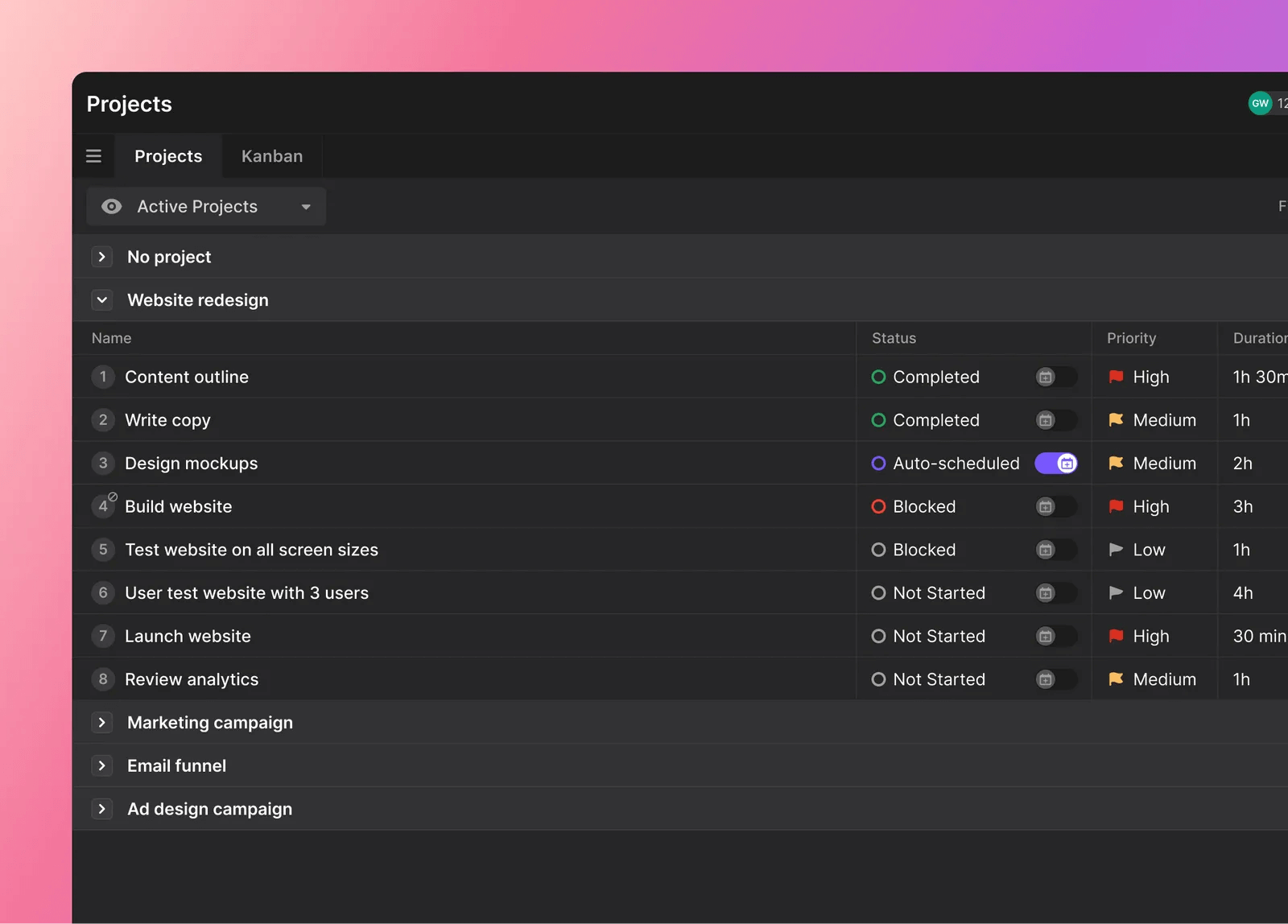 |
Planning a software project is a little more complex than making lunch. That's why it's even more important to create a detailed plan.
Why is software project planning so important?
Software project planning plays a vital role in the success of any software development endeavor. By carefully mapping out the project's roadmap and anticipating potential obstacles, you can significantly increase the chances of delivering a high-quality product on time and within budget.
Here's why software project planning should be front of mind:
- Clear direction: Planning helps you determine your goals, tasks, and responsibilities. Everyone involved needs to know what they're doing and when they're doing it.
- Risk mitigation: By identifying potential problems during the planning phase, you can develop strategies to avoid them. This proactive approach can help you avoid surprises and make it easier to solve problems.
- Easier to manage tasks: Planning helps you break down the project into smaller tasks, assign responsibilities, and set priorities. This organization makes it easier to manage each step and guarantees everyone is on the same page.
- Resource optimization: A well-thought-out project plan considers resource management, including allocating the right people to the right tasks, optimizing time and cost, and avoiding resource bottlenecks.
- Tracking progress: Planning involves determining metrics to measure and track project progress. Regularly monitoring these metrics helps you stay on top of the project's status and make timely adjustments.
What challenges can you face when planning a software project?
Developing a software project means many moving parts having to work together. When this is the case, lots of things can go wrong. Having a software project plan can alleviate several of the most common risks. Moreso, having a detailed software project plan will make the problems that inevitably arise easier to deal with.
Some common challenges you'll likely face are:
- Evolving provisions can make it difficult to define the scope and plan the project effectively.
- Insufficient resources, such as skilled personnel, budget, or time, can hinder project planning and execution.
- Project priorities may shift due to evolving business needs or stakeholder demands.
- Effective collaboration and communication among team members are vital for successful project planning.
- Engaging and managing stakeholders throughout the project lifecycle is essential.
- Complex software projects may involve intricate technologies, integrations, or dependencies.
- Identifying and mitigating project risks is crucial for minimizing potential obstacles, delays, and setbacks.
- Meeting deadlines and adhering to a project schedule can be challenging, especially when unexpected delays or changes occur.
- Scope creep is the uncontrolled expansion of project requirements or scope. If not managed properly, it can lead to schedule delays, increased costs, and compromised quality.
How do you create a software project plan?
Creating a software project plan involves ten important steps to ensure a successful and well-executed development process. Following these steps, you can effectively manage the project, meet stakeholder expectations and project costs, and deliver a high-quality software application on time and within budget.
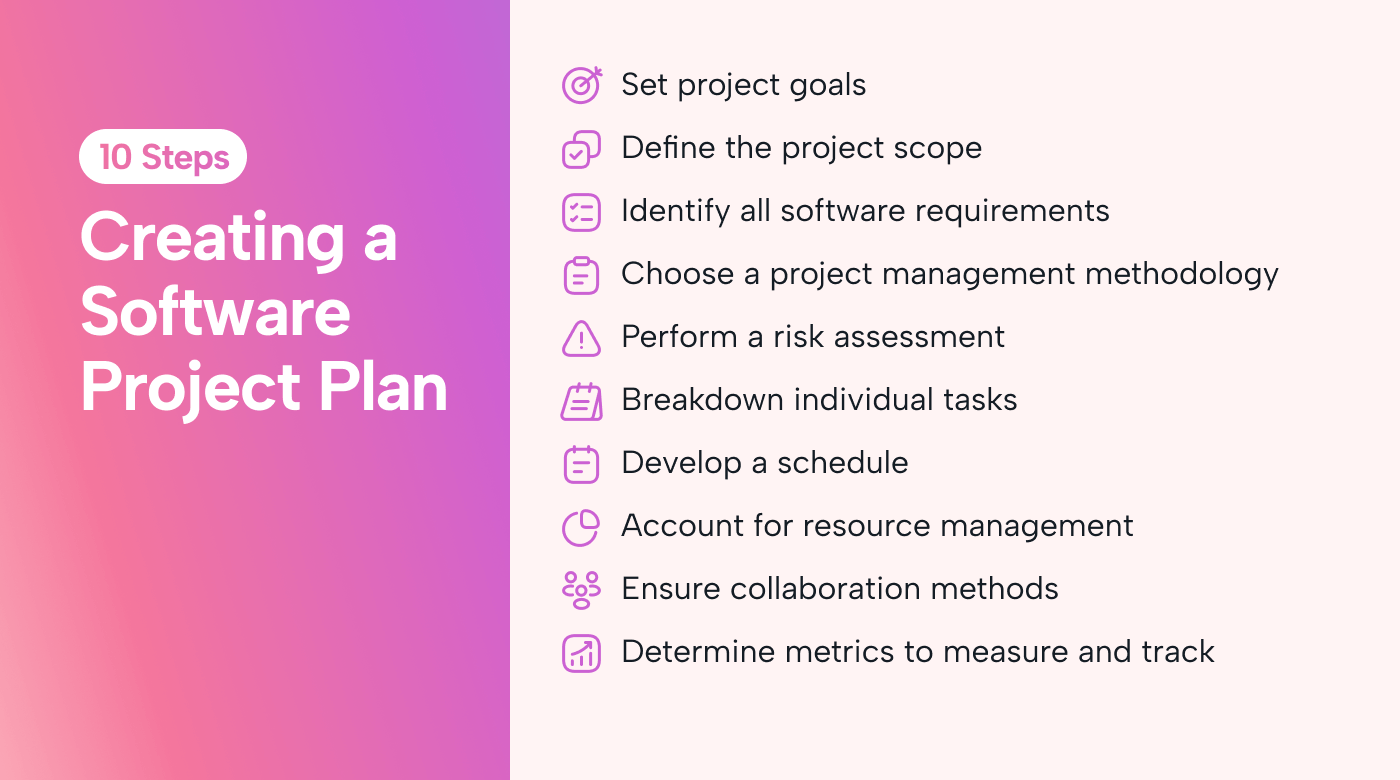 |
1. Define project goals
Establish the goals and objectives of the software product. For example, what problem does the software aim to solve? Understanding the goal sets the direction and focus of the entire project.
2. Define project scope
Define the project's scope, including its features, constraints, and exclusions. The project scope is a thorough roadmap or outline of the entire project. Without this, you can't create much of a plan at all.
3. Identify software requirements
To meet the project goals of the development team, gather a list of the software's functionalities and capabilities. This involves understanding user requirements, conducting market research, and considering industry standards. Defining these requirements is essential for creating software solutions that satisfy user expectations.
4. Choose a project management methodology
Select an appropriate project management methodology that aligns with the project's nature and requirements. Agile methods, such as Scrum or Kanban, are popular due to their iterative and flexible approach. This step helps establish a framework for organizing and executing the project's tasks.
5. Perform a risk assessment
Identify potential risks and challenges that may affect the project's success. Evaluate their impact and likelihood, and develop contingency plans to address them. You can minimize project disruptions and ensure progress by proactively identifying risks.
6. Break down individual tasks
Divide the project into smaller, manageable subtasks. This enables better planning, estimation, and allocation of resources. Effective task management also facilitates tracking progress and identifying dependencies between tasks and team members.
7. Build a schedule
Create a timeline that clearly defines the completion dates for each task or work package. When developing the schedule, consider the estimated effort, task dependencies, and resource availability. A well-defined schedule helps monitor progress, identify delays, and ensure timely delivery.
8. Resource management
Resource management is important for project success. It involves identifying and allocating resources, including people, hardware, software, and external dependencies. Effective resource management ensures that the right resources are available when needed, which can help avoid delays and setbacks.
9. Ensure collaboration methods
Establish effective communication and collaboration channels within the project team and with stakeholders. This includes regular team meetings, status updates, documentation, and feedback mechanisms. Open and transparent communication fosters teamwork so that everyone is on the same page and enables prompt issue resolution.
10. Determine metrics to track
Define specific metrics and key performance indicators (KPIs) to measure the project's progress and success. Metrics may include milestones achieved, functionality implemented, defects discovered and resolved, or customer satisfaction levels. Regularly tracking these metrics provides insights into project performance and allows for timely adjustments if needed.
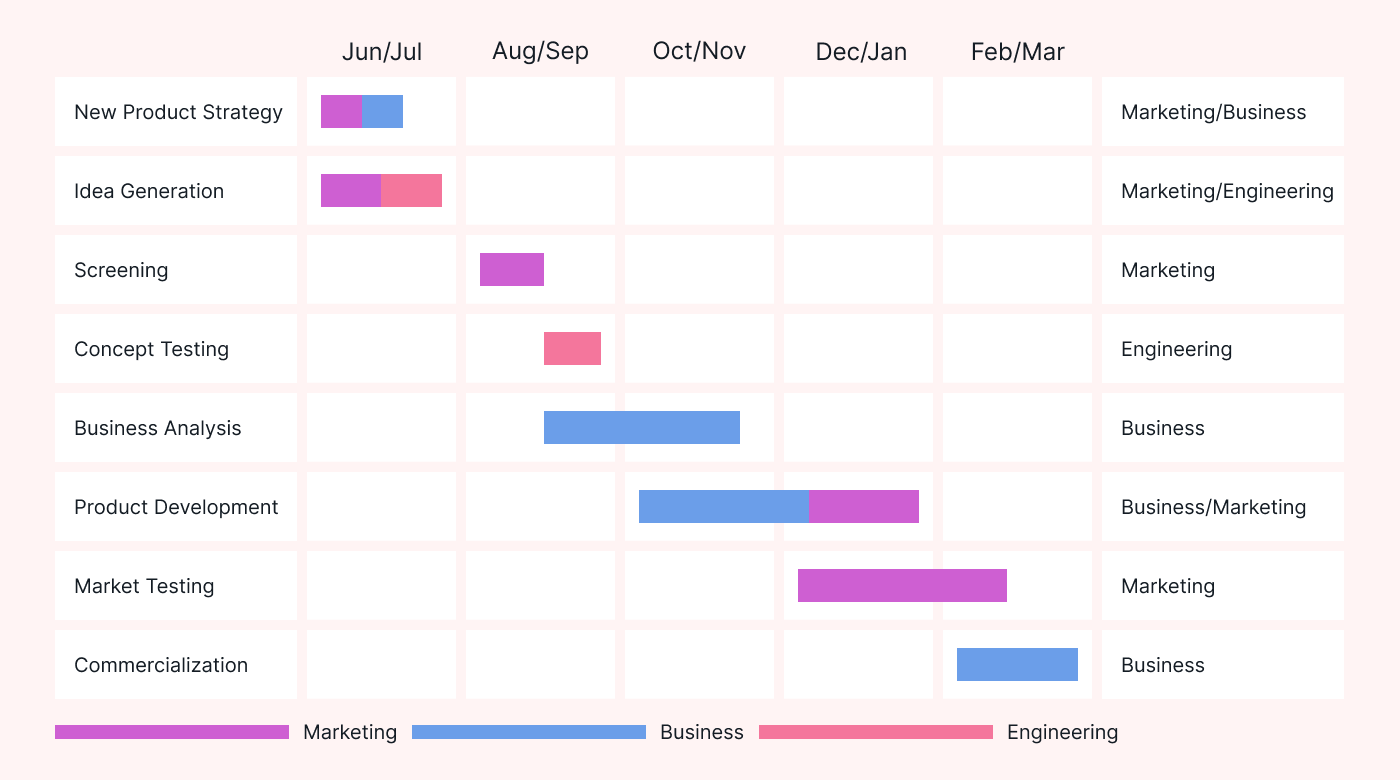 |
Following these steps, you can create a well-structured software project plan that sets clear goals, defines requirements, manages risks, and provides effective collaboration. Adaptability and flexibility are also important, as projects may require adjustments. Finally, a solid project plan provides a roadmap for success, guiding the project team toward delivering a high-quality software application that meets stakeholder expectations.
How does project management software make project planning easier?
Project management software simplifies the project planning process by providing a range of valuable features and functionalities. Here are the top seven features to look for in a project management platform for simpler software project planning:
Task assignments and priorities
Project management software allows for seamless task assignment to team members, providing clear responsibility and accountability. It enables setting priorities and deadlines, helping team members focus on critical tasks and effectively manage their workload. Project management software lets you track tasks and subtasks in real time.
Diverse project views
Project management software offers diverse project views, such as list views, Gantt charts, kanban boards, and calendars. These visual representations help in effective planning and decision-making by allowing teams to visualize project progress and timelines.
For example, Gantt charts offer a timeline-based view highlighting task durations, dependencies, and critical paths, enabling project managers to track progress and make informed decisions.
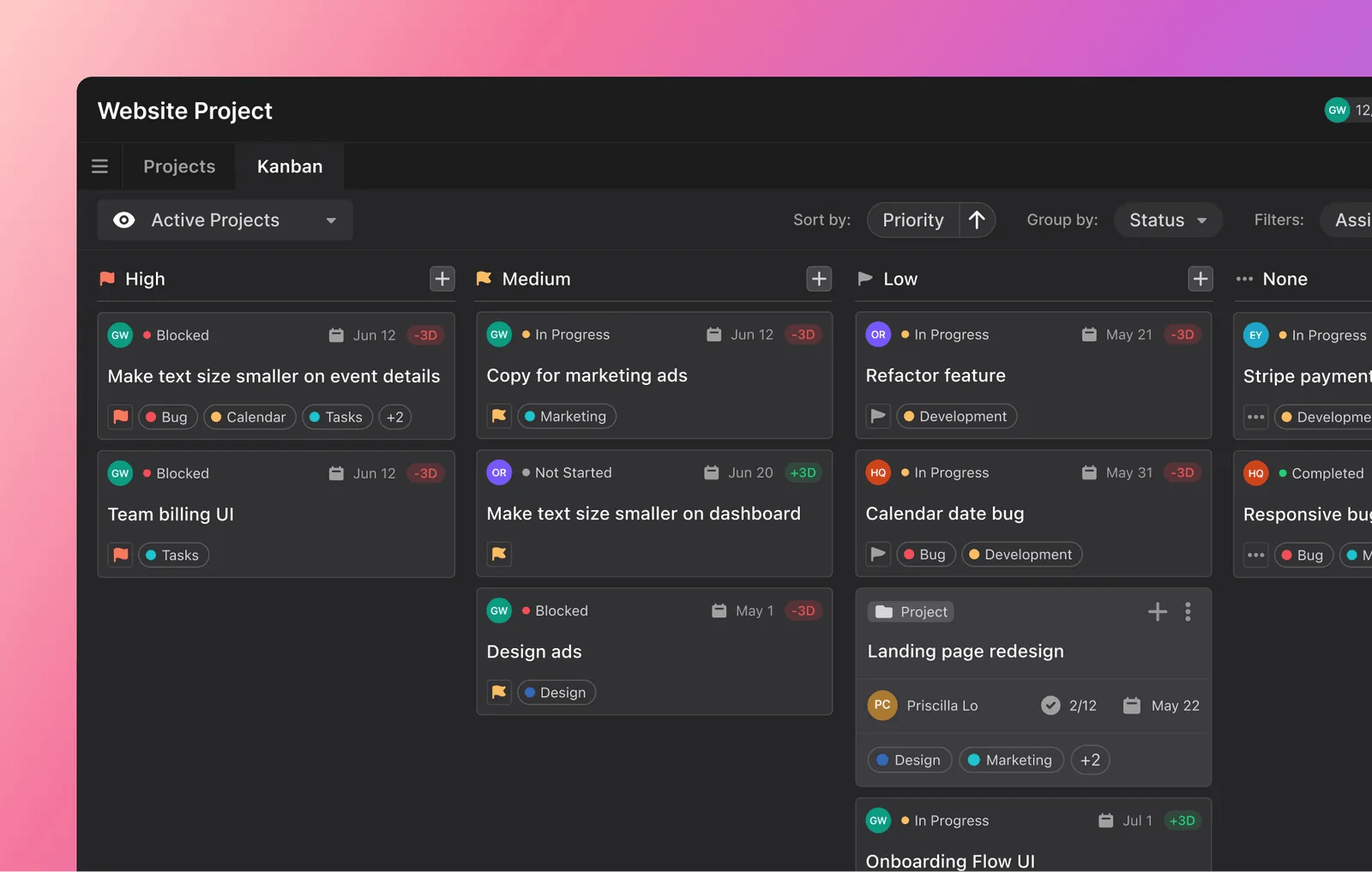 |
Inspired by Agile frameworks and subsets like Scrum, Kanban boards provide a visual workflow where tasks move across stages. This project view creates clarity and allows teams to manage work more iteratively.
Also, calendars offer a traditional view of project schedules, allowing stakeholders to see key milestones, deadlines, and resource availability. These diverse project views allow stakeholders to understand project progress at a glance.
Collaboration tools
Project management software includes collaboration features like file sharing, discussion boards, and real-time messaging. These tools facilitate seamless communication among team members, regardless of their physical location. They also provide a centralized platform for document storage and version control so that everyone can access up-to-date information. As a result, collaboration tools foster teamwork, enable knowledge sharing, and reduce communication gaps, improving overall project coordination and productivity.
Resource management
Project management software provides robust resource management capabilities that empower teams to allocate and manage resources effectively. They track resource availability, skill sets, and workload for optimal use of resources. With these features, teams can avoid overloading individuals, balance workloads, and identify resource gaps.
Efficiently managing resources maximizes productivity, reduces costs, and helps deliver projects on time.
Scheduling
Project management software offers built-in scheduling and calendar features that simplify project timeline management. It allows teams to create and manage project schedules easily. Assign dependencies to tasks, set milestones, and visualize project timelines.
By using the scheduling and calendar functionality, teams gain a clear overview of project timelines, track progress, and effectively manage deadlines.
App integration
Project management software integrates with popular business collaboration tools to improve stakeholder communication. Integrating messaging platforms and document-sharing platforms allows for simple information exchange.
Security and user permissions
Project management software prioritizes security by implementing robust measures to protect project data. Comprehensive user permissions enable leaders to control access levels and restrict data visibility. These controls guarantee sensitive project information is accessible only to authorized individuals.
Project management software provides confidentiality and integrity of project data by enforcing strict security measures.
The most effective project management tool for software project planning
Motion is an advanced and comprehensive project management software that simplifies the entire project lifecycle. With our easy-to-use, intuitive interface and powerful features, Motion empowers teams to plan, execute, and track their software development projects. We offer features designed to meet the needs of diverse teams and industries, from small startups to large enterprises.
Motion is also the only project manager that integrates industry-leading AI into the platform.
Stand-out features and benefits of Motion Project Management Software
- A user-friendly interface for easy task creation, assignment, and tracking, making sure teams stay organized and focused.
- Automate repetitive tasks and workflows, saving time and reducing manual effort.
- Reduce hours of unproductive work and time spent planning with an intelligent calendar. Motion’s calendar automatically updates as subtasks are completed.
- Leverage artificial intelligence to receive intelligent suggestions and recommendations for task prioritization, resource allocation, and project planning.
- Predictive analytics to forecast project timelines, resource needs, and potential risks, aiding in proactive decision-making.
- Receive notifications and reminders based on task deadlines, dependencies, and critical milestones.
- Centralize and organize project-related documents, providing easy access, smooth file sharing, up-to-date version control, and team collaboration.
- Agile methodologies such as Scrum or Kanban, or Gantt chart views align with team preferences and project requirements.
- Customize workflows and processes to fit the unique needs of your team and project.
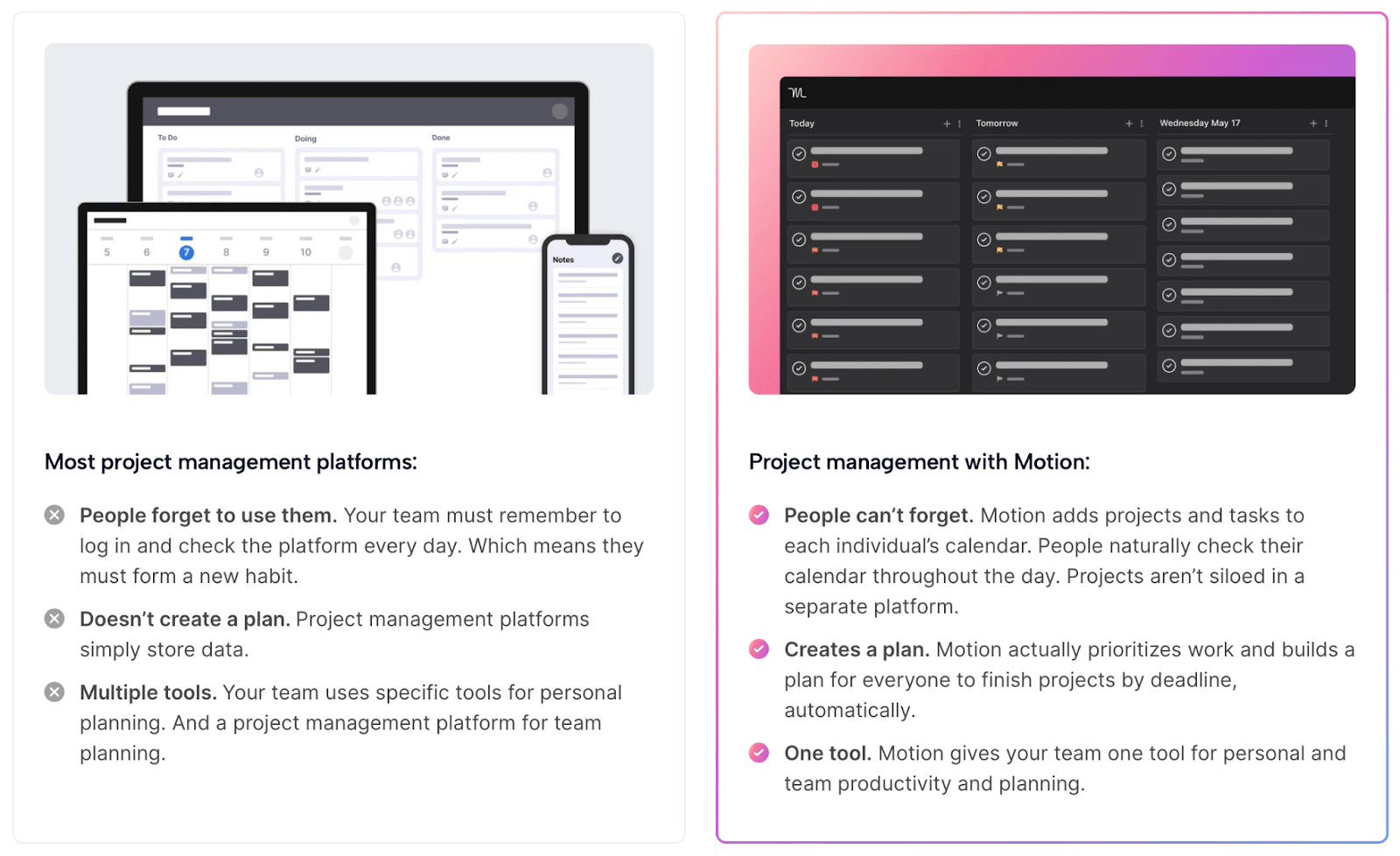 |
Get started planning your software project
The software project planning phase is paramount. The best way to accomplish successful products is by establishing clear goals, defining scope, identifying requirements, and mitigating risks. Project management software by Motion provides the tools and features needed to overcome the challenges faced during the planning process.
Experience the difference a project manager will make in your software project journey, and start your free trial with Motion today!





